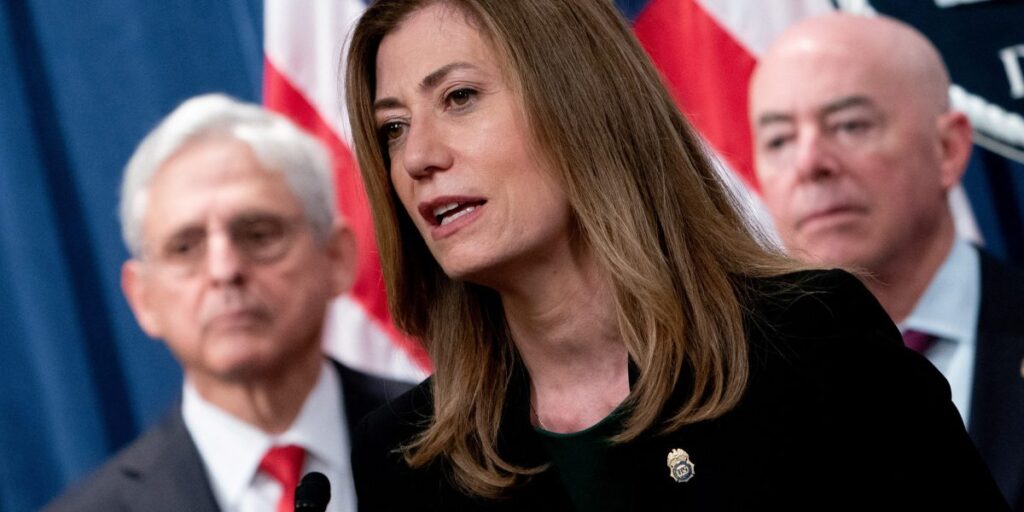
There was a white gift bag with a cheerful “Happy Birthday” printed on the side, but no gifts inside. Authorities say the Sinaloa drug cartel has $226,000 in cash that needs to be laundered.
The U.S. Justice Department on Tuesday announced a multi-count indictment charging more than a dozen members of the Los Angeles-based Mexican Sinaloa drug cartel and Chinese currency brokers with a multi-year conspiracy to launder money. The main defendant, Edgar Joel Martinez-Reyes, 45, is an East Los Angeles resident. To date, the investigation has resulted in the seizure of $5 million in cash, more than 300 pounds of cocaine, 92 pounds of methamphetamine, 3,000 ecstasy pills and 44 pounds of psychedelic mushrooms. According to the indictment, the list of defendants includes “Dr.” Peiji. P” Tong, Sai “Tommy” Zhang, Chengwu “Ocean” He, Raul “Batman” Contreras, Jiaxuan “Edward” He, Diego Acosta Ovalle and more.
The first 20 defendants will be arraigned in the coming weeks and each faces at least 10 years in prison or up to life in prison if convicted on all charges.
“Relentless greed and the pursuit of money drive Mexican drug cartels, who are responsible for the worst drug crisis in U.S. history,” DEA Director Anne Milgram said in a statement. “The DEA “This investigation uncovered partnerships between Sinaloa Cartel associates and Chinese criminal groups operating money laundering operations in Los Angeles and China.”
The U.S. Justice Department said the drug cartel, based in the Mexican state of Sinaloa, was behind a surge in fentanyl imports into the U.S. over the past eight years, raising large amounts of cash. To move funds to Mexico, cartel members turned to Chinese currency exchanges in the United States, authorities said. To set it up, Martinez-Reyes and “Dr. P” Tong allegedly traveled to Mexico about four years ago to sign contracts to launder the cartel’s drug profits in exchange for commissions.
After the agreement is reached, drug traffickers deliver large amounts of cash to money brokers for money laundering purposes. To disguise the cash, the defendants used gift bags, reusable shopping bags, backpacks, boxes of Fruit Pebbles and other items to conceal the cash, authorities said.
Prosecutors said couriers purchased cryptocurrencies or deposited money into bank accounts in small, structured packages. The indictment states that cryptocurrency could be easily transferred into accounts held by the Sinaloa Cartel. Other methods of laundering money include buying precious metals and gemstones and taking them to Mexico to sell them.
The indictment outlines a complex scheme involving Chinese currency exchange. Currency exchange agencies that work with the cartels also provide assistance to wealthy Chinese citizens who have invested in China and want to move their funds to the United States but are prohibited by the Chinese government, the Justice Department said. Chinese regulations prohibit people from moving more than $50,000 out of the country each year.
To circumvent the restrictions, Chinese residents use brokers who sell U.S. dollars, authorities said. The broker provides Chinese residents with bank account details in China, as well as instructions for depositing yuan into the account. Once the account holder confirms the deposit, the equivalent amount in US dollars is provided to the US broker. Brokers obtain cash from drug cartels and charge a commission of approximately 0.5% to 2% of the total amount to conceal drug money. (Authorities say traditional money launderers charge much higher fees than Chinese money launderers, ranging from 5% to 10% or even higher.)
“Drug traffickers are increasingly working with China’s underground currency exchanges to take advantage of Chinese citizens’ overwhelming demand for U.S. dollars,” the U.S. Department of Justice said.
The indictment alleges that the brokers either delivered U.S. dollars directly to clients or purchased properties, luxury goods and cars to be shipped to China. Authorities said money transferred in China was used to buy consumer goods for Mexican businesses or chemicals used to make more narcotics.
“This case is a classic example of Chinese money launderers teaming up with drug traffickers to try to legitimize the profits generated by drug activities,” said Guy Fico, Chief of Criminal Investigations for the IRS.

